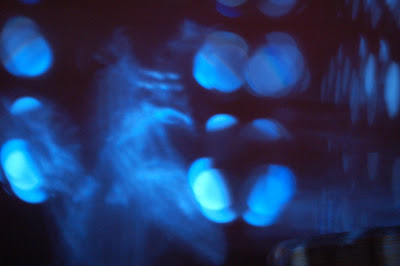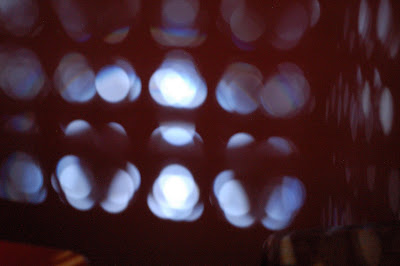










 This piece is Miss Understood and Mr Meanor, 1997. It was made over the course of six months from the artists garbage - the remains of what they survived off of during the time they were making the work. Most of their shadow work, that I've seen, are self portraits.
This piece is Miss Understood and Mr Meanor, 1997. It was made over the course of six months from the artists garbage - the remains of what they survived off of during the time they were making the work. Most of their shadow work, that I've seen, are self portraits.I went to Ally’s SMP presentation with a few ideas in mind of what it had to do with because I had heard about a lot of the preparatory works she was doing. I also went to the gallery opening to see if I what I got from the work would be what she talked about during her presentation.
Her final works use the image of a fingerprint mainly. She talked about how people leave imprints everywhere they go, connecting unknowingly with strangers through shared spaces and objects. That is probably one of the most basic things to say about her pieces, but it is what struck me the most. She chose the fingerprint because it is the “physical manifestation of where we’ve been.” I am mainly going to talk about her hanging installation. She made six large pieces on Plexiglas with a simplified drawing of a fingerprint on each. She used black and white paint as well as cutting out shapes and used bubble wrap to add texture on some. All of them are graphic pieces on their own, but what is interesting about them to me is the way they are hung. Because they are hung in a way that you could walk through them from any area and because they are transparent, the viewer gets the sense of going on their own path while overlapping with others. Even the fingerprints themselves can overlap, but they are never touching. This is the same as how strangers lives can overlap or not, but the people never actually meet. [My favorite part of her presentation is when she talked about the day she spent taking pictures of everyone who went to the same gas pump.]
I don’t have really anything to say in terms of how to improve her work. I would enjoy seeing some of the projects she did throughout the year, like Letters to Someone, incorporated into a work she would do. I guess that would make it more personal to her and be about how she connected (imprinted) with all of these people through her study of other peoples lives.
During our class there was a performance that was supposed to emulate a Dada performance. It was presented by one of the Art history classes. We walked to Upper Monty where there were tape outlines of bodies on the floor with people-like figures made with clothing and various items that had been stuffed in some way. I had already seen these in the building and had no idea what they would be for.
While sitting and waiting for the performance to start, most people from the class were talking to each other. I was mainly trying to be quiet and wait because I am particularly interested in Dada and was afraid something would happen and I wouldn't notice it. Julia and I noticed there was a group of students sitting in chairs who were endlessly texting. Only once during the first part of the performance did they look up at each other to talk and it had something to do with youtube. As time went on and the audience only got louder, it seemed as though they might be waiting for people to become quiet. To see how long it took people to figure out that what they were doing is part of the performance, since it is such a common sight nowadays. Eventually most people from our class left, thinking that this had been the entire performance. This is when things started to "pick up." The students sitting on their phones got up to leave, saying goodbye as if they had been hanging out. One of them came back riding a bike and the rest filtered in. They put the bike up on a white box as if for display and brought a board with pre-donutted tape and a box of magazine clippings. They started to tape them onto the bike. Everyone watching, including Julia and I, participated. When all of the tape was used up, they ripped all of the pieces off, took the bike down, and the same person who rode it in rode out on it. Of few of the students left the room, some of them moving the fake bodies on the floor slightly out of the tape surrounding them. Eventually all of them left and two returned and started talking about what they were going to do for the rest of the day until everyone left.
I thought the performance was incredibly interesting. I thought there was a great mix of things happening that made it clear there was a performance happening as well as things that could easily be overlooked and seen as typical behavior. It seemed to be a commentary on how technology/interacting through technology has replaced simply spending time with people. Spending time together is constantly being interrupted by texting and hardly ever am I around my friends for a whole day without sitting in a room where at least half of us are on our laptops. It is strange that technology has increased opportunities for communication and simultaneously limited communication. It is so easy to get wrapped up in your own little online world that people forget how to connect with people in real life.
A good friend of mine recently broke her phone. It has been a week or so since then and she’s been living without the quickest mode of communication. It has made things a little bit difficult in terms of getting a hold of her (she lives off campus so it’s hard to know where she is unless she is online). I talked to her about how it makes her feel not to have a phone and she loves it. She loves that she only really has to respond to herself and not deal with random texts asking “where you at?” Not that she dislikes these, but it is nice to not have to deal with it all the time. This is something I’ve been having trouble with lately. I love having my phone in case I need to get a hold of someone or if they need to get a hold of me, but it has increasingly been irritating to have to deal with my phone during the day. I have to worry about all of the things people text me about when I am busy worrying about all of the things I have to get done. It used to be that I felt weird not texting a lot throughout the day because it just became a habit, but it has started to increasingly make me feel the need for a break.
I feel that the performance definitely addressed the fact that people are far too attached to our portable technology and they need to step away from it (outside of the lines around the bodies on the floor, if you will) in order to connect to other people. The message came across clearly through the undefined interactive structure. I thought the fact that they waited so long was confusing and interesting, definitely seemed to hearken back to Dada. I think they accomplished recreating the experience of being at a Dada performance (as best I can because I’ve never actually been to one…). I don’t think I would change anything except the group of three students separate from the other five were also on their phones, but they weren’t as absorbed in them. I am uncertain if this was intentional or if they were playing their roles less intensely. Either way, the message comes across and I had a great time viewing and interacting with it.









